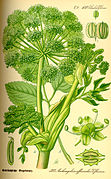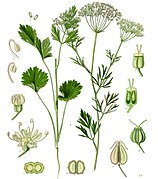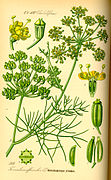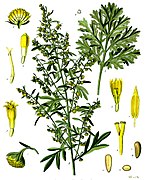Absinthe
![]()
Green Fairy is a redirect to this article. For the German pulp magazine, see Die Grüne Fee.
Absinthe, also called absinthe or wormwood spirit, is an alcoholic drink traditionally made from wormwood, anise, fennel, a number of other herbs that vary according to the recipe, and alcohol.
Most absinthe brands are green, which is why absinthe is also called "The Green Fairy" (French La fée verte). The alcohol content is usually between 45 and 89 percent by volume and thus belongs to the upper range of spirits. Due to the use of bitter-tasting herbs, especially wormwood, absinthe is considered a bitter spirit, although it does not necessarily taste bitter.
Absinthe was originally produced in the 18th century in the Val de Travers in what is now the Swiss canton of Neuchâtel (République et Canton de Neuchâtel) as a medicinal remedy. This spirit, which is traditionally drunk mixed with water, became very popular in France in the second half of the 19th century and the early 20th century. Famous absinthe drinkers include Charles Baudelaire, Paul Gauguin, Vincent van Gogh, Ernest Hemingway, Edgar Allan Poe, Arthur Rimbaud, Aleister Crowley, Henri de Toulouse-Lautrec and Oscar Wilde.
At the height of its popularity, the drink had a reputation for being addictive and causing serious health problems due to its thujone content. By 1915, the drink was banned in a number of European countries and the USA. Modern studies have not been able to prove any harm from absinthe consumption beyond the effects of alcohol; the health damage found at the time is now attributed to the poor quality of the alcohol and the high amounts consumed. Since 1998 absinthe has been available again in most European countries. In Switzerland, too, the production and sale of absinthe has been permitted again since 2005.

Reservoir glass with naturally coloured absinthe and absinthe spoon
Ingredients
Herbs used
In addition to wormwood (Artemisia absinthium), absinthe made in France and Switzerland contains anise, sometimes replaced by the less expensive star anise, fennel, hyssop, lemon balm, and Pontic wormwood. Variants also use angelica, calamus, Origanum dictamnus, coriander, veronica, juniper, nutmeg, and various other herbs. Wormwood, anise and fennel make up the typical taste of absinthe. The remaining spices serve to round off the taste. The green color that many absinthe varieties exhibit comes from the chlorophyll in pontic wormwood, hyssop, lemon balm and mint.
· 
Angelika
· 
Anise
· 
Fennel
· 
Wormwood
Thujone
→ Main article: Thujone
Thujone is a component of wormwood essential oil used in absinthe production. The harmful effects seen in France during the height of absinthe popularity in the 19th century, which included dizziness, hallucinations, delusions, depression, convulsions, blindness, and mental and physical deterioration, were attributed to this substance. Thujone is a neurotoxin that can cause confusion and epileptic spasms (convulsions) in higher doses. For this reason, thujone content in alcoholic beverages has been limited in the European Union (5 mg/kg in alcoholic beverages containing up to 25% alcohol by volume and up to 10 mg/kg in alcoholic beverages containing more than 25% alcohol by volume and up to 35 mg/kg in bitter spirits).
The convulsive effect of absinthe observed in particular in animal experiments of the 19th century is now attributed to a blocking of GABAA receptors and a desensitization of serotonin 5-HT3 receptors by thujone. However, it has now been disproved that the amount of thujone contained in absinthe is sufficient to have a pharmacodynamic effect to this degree. More likely as a cause or major factor is the alcohol contained in absinthe. Also a possible common mechanism of action with the cannabis active ingredient tetrahydrocannabinol via an activation of cannabinoid receptors could not be confirmed. A euphoric and aphrodisiac effect of today's absinthes proclaimed in the club scene and in the media cannot be attributed to the thujone dose contained in these drinks on the basis of these experimental data.
19th century absinthe, contrary to earlier reports that spoke of up to 350 milligrams per liter, had essentially no higher thujone content than today's regulated absinthes. In a study of absinthes based on historical recipes and processes and absinthe produced in 1930, only thujone levels below 10 mg/kg were detected. However, the thujone content may be higher if wormwood extracts or wormwood oils are added. However, the absinthes become very bitter in this way.
Alcohol
→ Main article: Ethanol
The alcohol content of historical absinthes was between 45 and 78%. With few exceptions, the absinthes available today are also in this range. Absinthe is also available with an alcohol content of up to 90%. Because of the high alcohol content, absinthe is usually drunk diluted.
Historically, there are five quality grades: Absinthe des essences, Absinthe ordinaire, Absinthe demi-fine, Absinthe fine and Absinthe Suisse, whereby Absinthe des essences represents the lowest alcohol content and the lowest quality. Absinthe Suisse does not refer to the country of production, but to a particularly high alcohol content and high quality.
In retrospect, it is no longer thujone but the alcohol content of absinthe that is considered today to be the primary cause of the absinthism that became widespread in the 19th and early 20th centuries. In 1914, the amount of pure alcohol consumed per capita by French adults was 30 liters per year. In comparison, today (2013, according to WHO) Moldova leads the world in alcohol consumption statistics with 18.22 liters of pure alcohol per adult. The symptoms of absinthism do not differ from those of chronic alcohol abuse (alcoholism).
Other ingredients
An additional problem with 19th century absinthe was that the alcohol used was often inferior and contained a lot of amyl alcohol and other fusel oils. Also methanol, which causes dizziness, headaches and nausea and as a late consequence blindness, shaking paralysis or in case of an overdose death, was contained in the absinthe of that time. To give absinthe its characteristic colour, additives such as aniline green, copper sulphate, copper acetate and indigo were sometimes added. Likewise, antimony trichloride was added to produce the Louche effect (the milky cloudiness of the otherwise clear drink when diluted with water or very chilled). However, concentrations of potential contaminants such as pinocamphone, fenchone, alcohol impurities, copper ions, and antimony ions found in historical samples were within a range unsuspicious for inference of absinthism.

Structural formula of the ingredient ethanol

Structural formula of the ingredient thujone
Manufacture
In the production process, wormwood, anise and fennel are macerated (steeped) in neutral alcohol or wine alcohol and then distilled. The distillation helps to separate the strong bitter substances of wormwood. These are less volatile than the aromatics and are left behind during distillation. Otherwise, the result would be unpleasant to undrinkably bitter. A disproportionate bitterness in absinthe can be an indication that distillation was completely or partially omitted in the production, wormwood extracts were used in the production and it could be inferior or fake absinthe.
The distillate can be coloured with herbs such as pontic wormwood, lemon balm and hyssop. Colouring with herbs contributes to the overall taste of the final product. It places high demands on the skills of the producer in the selection of the colouring herbs, their quantitative ratio and the duration of the colouring. In old absinthe, the colouring of the drink can change from an originally bright green to a yellowish green or brown as the chlorophyll decomposes. Very old absinthes are occasionally amber in color. Clear absinthe, also called "Blanche" or "La Bleue", is typical of absinthe produced in illegal distilleries in Switzerland. The absence of the colouring normally typical of absinthe facilitated clandestine sales in times when absinthe was banned in Switzerland.
Today, absinthe is often produced by adding absinthe essence to high-proof alcohol. It is only from the upper middle class that classic production methods such as maceration are used. Some of the absinthes produced today are coloured with food colouring. These are also mostly inferior absinthes with a simplified production process that robs the absinthe of important nuances of taste. Besides the "Green Fairy" there are also red, black or blue coloured Absinthe. This unusual coloring for absinthe is mainly done for marketing reasons.

Assortment of modern absinthes
Questions and Answers
Q: What is absinthe?
A: Absinthe is a distilled, highly alcoholic beverage with anise-flavoured spirit derived from herbs including the flowers and leaves of Artemisia absinthium ("grand wormwood"), together with green anise, sweet fennel. It can be naturally green in colour or colourless.
Q: How strong is absinthe?
A: Absinthe has an alcohol content of 45–74% by volume / 90–148 U.S. proof).
Q: Where did absinthe originate from?
A: Absinthe originated from Val-de-Travers, Switzerland.
Q: When was it popular?
A: Absinthe was very popular in late 19th and early 20th century France, particularly among Parisian artists and writers.
Q: Was there any evidence to suggest that absinthe had dangerous effects?
A: The chemical compound thujone, although present in the spirit in only trace amounts, was blamed for its alleged harmful effects; however it has not been shown to be any more dangerous than ordinary spirits. Recent studies have suggested that these psychoactive effects were exaggerated.
Q: When was it banned?
A: By 1915, absinthe had been banned in the United States and much of Europe including France, the Netherlands, Belgium, Switzerland and Austria-Hungary.
Q: Is there a revival of absinthe now?
A Yes - a revival of absinthe began in the 1990s after modern European Union food and beverage laws removed barriers to its production and sale; by the early 21st century nearly 200 brands were being produced across several countries such as France, Switzerland Australia Spain and Czech Republic
Search within the encyclopedia